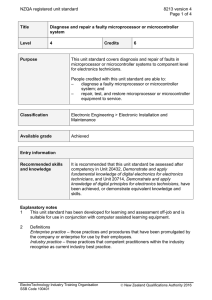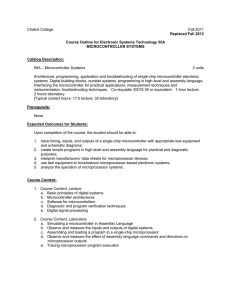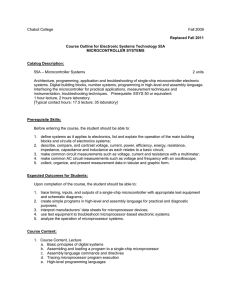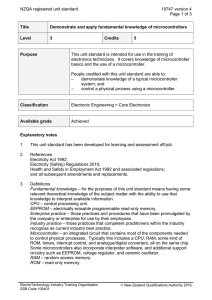NZQA registered unit standard 20714 version 2 Page 1 of 4
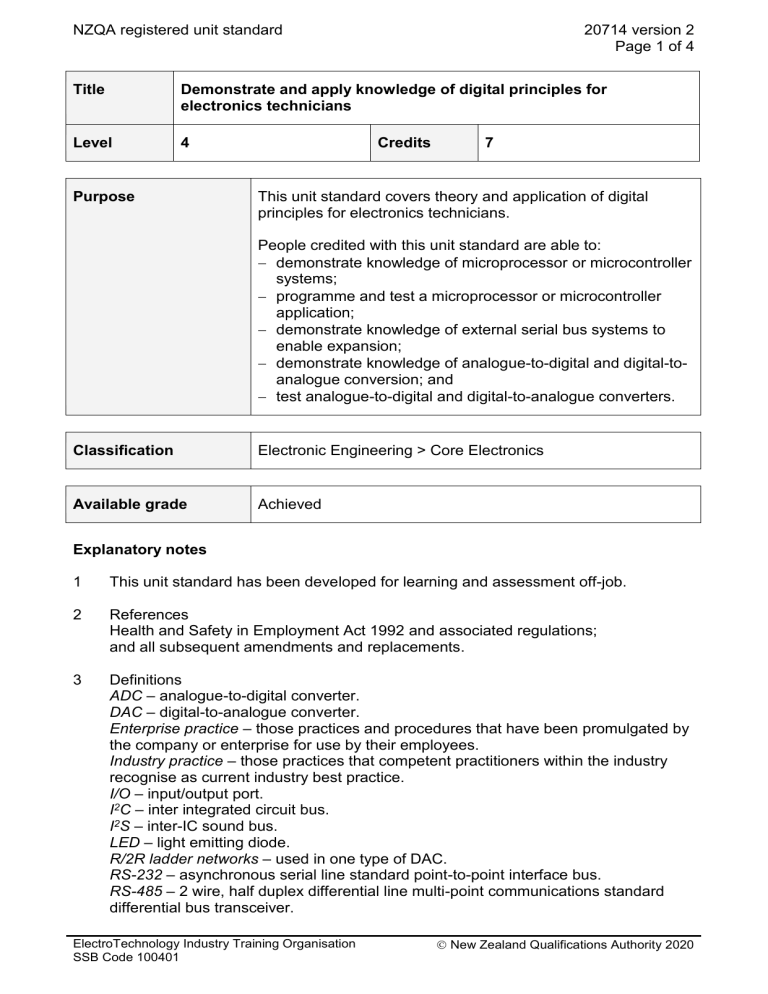
NZQA registered unit standard
Title
20714 version 2
Page 1 of 4
Demonstrate and apply knowledge of digital principles for electronics technicians
Level
Purpose
4 Credits 7
This unit standard covers theory and application of digital principles for electronics technicians.
People credited with this unit standard are able to:
demonstrate knowledge of microprocessor or microcontroller systems;
programme and test a microprocessor or microcontroller application;
demonstrate knowledge of external serial bus systems to enable expansion;
demonstrate knowledge of analogue-to-digital and digital-toanalogue conversion; and
test analogue-to-digital and digital-to-analogue converters.
Classification Electronic Engineering > Core Electronics
Available grade Achieved
Explanatory notes
1 This unit standard has been developed for learning and assessment off-job.
2 References
Health and Safety in Employment Act 1992 and associated regulations; and all subsequent amendments and replacements.
3 Definitions
ADC – analogue-to-digital converter.
DAC – digital-to-analogue converter.
Enterprise practice
– those practices and procedures that have been promulgated by the company or enterprise for use by their employees.
Industry practice – those practices that competent practitioners within the industry
I recognise as current industry best practice.
I/O
– input/output port.
2 C – inter integrated circuit bus.
I 2 S – inter-IC sound bus.
LED
– light emitting diode.
R/2R ladder networks
– used in one type of DAC.
RS-232 – asynchronous serial line standard point-to-point interface bus.
RS-485 – 2 wire, half duplex differential line multi-point communications standard differential bus transceiver.
ElectroTechnology Industry Training Organisation
SSB Code 100401
New Zealand Qualifications Authority 2020
NZQA registered unit standard 20714 version 2
Page 2 of 4
SPI – serial peripheral interface.
4 Range a For the purposes of this unit standard, any type of microprocessor or microcontroller may be used when programming and testing. b Electrical, radiation, and workshop or laboratory safety practices are to be observed at all times. c All activities and evidence presented for all outcomes and evidence requirements in this unit standard must be in accordance with legislation, policies, procedures, ethical codes, Standards, applicable site and enterprise practice, and industry practice; and, where appropriate, manufacturers’ instructions, specifications, and data sheets.
Outcomes and evidence requirements
Outcome 1
Demonstrate knowledge of microprocessor or microcontroller systems.
Evidence requirements
1.1 Given a functional block diagram, the architecture of a typical microprocessor or microcontroller is described.
Range description must include the purpose of each functional block and the flow of information and data.
1.2
1.3
The programming of a microprocessor or microcontroller is outlined.
Given a block diagram, the operation of a microprocessor or microcontroller is explained.
Range clock, reset, fetch, execute cycle, read/write cycle to peripheral devices.
Outcome 2
Programme and test a microprocessor or microcontroller application.
Evidence requirements
2.1 A simple assembler or high level language programme is written, debugged, and tested to enable a microprocessor or microcontroller to interface with peripheral devices.
Range programme is required to read simple digital input devices such as switches or opto-couplers, and process these to produce some output algorithm to a digital output such as LEDs, relays, solenoids.
ElectroTechnology Industry Training Organisation
SSB Code 100401
New Zealand Qualifications Authority 2020
NZQA registered unit standard
2.2
20714 version 2
Page 3 of 4
A simple assembler or high-level language software test routine to test the operation of two programmable peripheral interface devices is written, debugged, and tested.
Range may include – programmable I/O parallel port, programmable serial port, programmable timer.
2.3 The operation of the interrupt structure is explained, and a simple programme exploiting the interrupt feature of a programmable peripheral device is written, debugged, and tested.
Outcome 3
Demonstrate knowledge of external serial bus systems to enable expansion.
Range may include but is not limited to – RS-232, RS-485, I2C, I2S, SPI, J-Tag.
Evidence of two is required.
Evidence requirements
3.1 The use of two bus systems is identified and their operation using sample frames is explained.
3.2 Use of these bus systems to provide I/O expansion, control, or transfer of data in commercial electronics products or systems is explained.
Outcome 4
Demonstrate knowledge of analogue-to-digital and digital-to-analogue conversion.
Evidence requirements
4.1 Terms associated with analogue-to-digital and digital-to-analogue conversion are explained.
Range terms – servo or counter, successive approximation, dual slope, flash, delta-sigma, weighted networks, one bit DAC, DAC using
R/2R ladder networks, resolution, quantisation, conversion time, linearity, offset, gain errors.
4.2 The operation of ADCs and DACs is explained.
Range two ADCs and one DAC.
4.3 ADCs and DACs are identified in the circuits of commercial electronic products, and the functions of the ADCs and DACs are described.
ElectroTechnology Industry Training Organisation
SSB Code 100401
New Zealand Qualifications Authority 2020
NZQA registered unit standard 20714 version 2
Page 4 of 4
Outcome 5
Test analogue-to-digital and digital-to-analogue converters.
Evidence requirements
5.1 An ADC and a DAC are tested and parameters measured.
Range parameters – conversion rate, resolution, offset, gain, linearity errors, microcontroller based converters may be tested.
Planned review date 31 December 2016
Status information and last date for assessment for superseded versions
Process Version Date Last Date for Assessment
Registration 1 26 July 2004 31 December 2012
Review 2 21 July 2011 N/A
Consent and Moderation Requirements (CMR) reference 0003
This CMR can be accessed at http://www.nzqa.govt.nz/framework/search/index.do
.
Please note
Providers must be granted consent to assess against standards (accredited) by NZQA, before they can report credits from assessment against unit standards or deliver courses of study leading to that assessment.
Industry Training Organisations must be granted consent to assess against standards by
NZQA before they can register credits from assessment against unit standards.
Providers and Industry Training Organisations, which have been granted consent and which are assessing against unit standards must engage with the moderation system that applies to those standards.
Requirements for consent to assess and an outline of the moderation system that applies to this standard are outlined in the Consent and Moderation Requirements (CMRs). The
CMR also includes useful information about special requirements for organisations wishing to develop education and training programmes, such as minimum qualifications for tutors and assessors, and special resource requirements.
Comments on this unit standard
Please contact the ElectroTechnology Industry Training Organisation reviewcomments@etito.co.nz
if you wish to suggest changes to the content of this unit standard.
ElectroTechnology Industry Training Organisation
SSB Code 100401
New Zealand Qualifications Authority 2020
